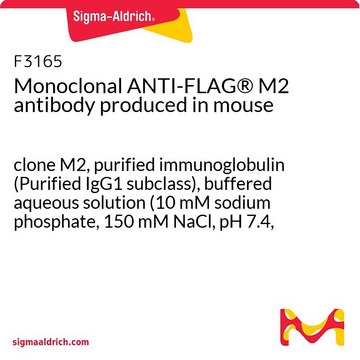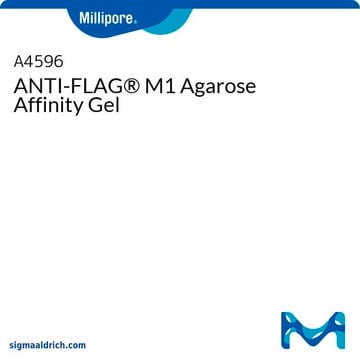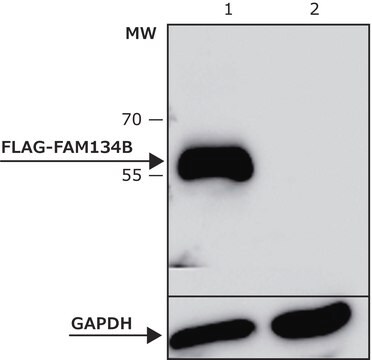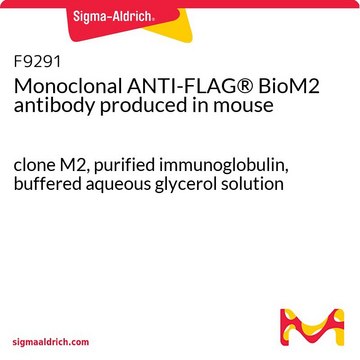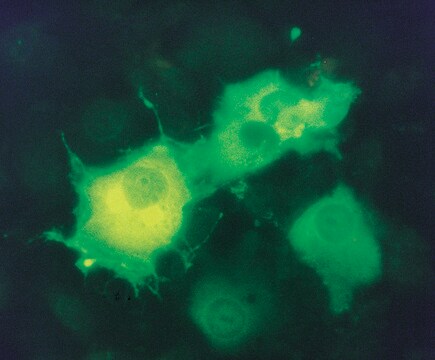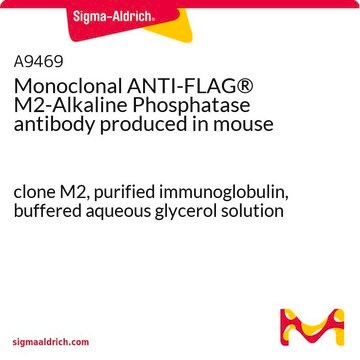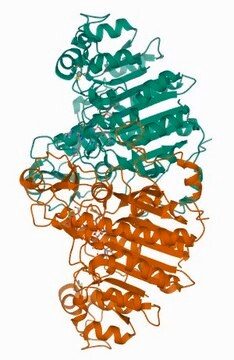Alle Fotos(1)
Wichtige Dokumente
F3040
Monoklonaler ANTI-FLAG®-M1-Antikörper in Maus hergestellte Antikörper
clone M1, purified immunoglobulin, buffered aqueous solution
Synonym(e):
Anti-ddddk, Anti-dykddddk
Anmeldenzur Ansicht organisationsspezifischer und vertraglich vereinbarter Preise
Alle Fotos(1)
About This Item
Empfohlene Produkte
Biologische Quelle
(Bioreactor)
Konjugat
unconjugated
Antikörperform
purified immunoglobulin
Antikörper-Produkttyp
primary antibodies
Klon
M1, monoclonal
Form
buffered aqueous solution
Aufgereinigt durch
using Protein A
Speziesreaktivität
all
Konzentration
2-5 mg/mL
Methode(n)
western blot: 10 μg/mL
Immunogene Sequenz
DYKDDDDK
Versandbedingung
dry ice
Lagertemp.
−20°C
Allgemeine Beschreibung
Der monoklonale Antikörper ANTI-FLAG M1 IgG2b bindet am freien N-Terminus an Proteine mit einem FLAG-Marker.
Aufbereitungsmethode – Protein A
Aufbereitungsmethode – Protein A
Immunogen
FLAG; Peptid-Sequenz DYKDDDDK
Anwendung
Der monoklonale ANTI-FLAG®-M1-Antikörper ist für die Immunpräzipitation, Western Blot oder EIA in Hefe-, Tier- und E.-coli-Zellen geeignet.
Anwendungen, bei denen dieser Antikörper erfolgreich eingesetzt wird, und die dazugehörigen Peer-Review-Papers sind nachstehend aufgeführt.
Chromatin-Immunpräzipitation (1 Paper)
Immunfluoreszenz (1 Paper)
Weitere Produktinformationen finden Sie in unserem FLAG-®Literatur-Portal.
Anwendungen, bei denen dieser Antikörper erfolgreich eingesetzt wird, und die dazugehörigen Peer-Review-Papers sind nachstehend aufgeführt.
Chromatin-Immunpräzipitation (1 Paper)
Immunfluoreszenz (1 Paper)
Weitere Produktinformationen finden Sie in unserem FLAG-®Literatur-Portal.
Biochem./physiol. Wirkung
Bindet an das FLAG-Epitop, wenn es sich am freien Aminoterminus eines Fusionsproteins befindet. Bindet nicht an Met-FLAG-Fusionsproteine, weshalb es keine unverarbeiteten, zytoplasmatisch exprimierten Proteine erkennt. Die Bindung ist Ca2+-abhängig; der Komplex dissoziiert bei Abwesenheit von Calciumionen.
Physikalische Form
Lösung in 10 mM Natriumphosphat, 150 mM NaCl (pH 7,4) mit 0,02 % (w/v) Natriumazid.
Angaben zur Herstellung
Antikörper zu 10 μg/mL in 0,05 M TBS (pH 7,4) mit 1 mM CaCl2 verdünnen.
Sonstige Hinweise
Rechtliche Hinweise
ANTI-FLAG is a registered trademark of Merck KGaA, Darmstadt, Germany
FLAG is a registered trademark of Merck KGaA, Darmstadt, Germany
Sie haben nicht das passende Produkt gefunden?
Probieren Sie unser Produkt-Auswahlhilfe. aus.
Lagerklassenschlüssel
10 - Combustible liquids
WGK
WGK 1
Flammpunkt (°F)
Not applicable
Flammpunkt (°C)
Not applicable
Hier finden Sie alle aktuellen Versionen:
Besitzen Sie dieses Produkt bereits?
In der Dokumentenbibliothek finden Sie die Dokumentation zu den Produkten, die Sie kürzlich erworben haben.
Kunden haben sich ebenfalls angesehen
C Nie et al.
Cell death & disease, 5, e1495-e1495 (2014-10-31)
The protein kinase inhibitor 7-hydroxystaurosporine (UCN-01) is one of the most potent and frequently used proapoptotic stimuli. The BH3-only molecule of Bcl-2 family proteins has been reported to contribute to UCN-01-induced apoptosis. Here we have found that UCN-01 triggers Puma-induced
Andrew Best et al.
Nature communications, 5, 4760-4760 (2014-09-12)
Alternative splicing--the production of multiple messenger RNA isoforms from a single gene--is regulated in part by RNA binding proteins. While the RBPs transformer2 alpha (Tra2α) and Tra2β have both been implicated in the regulation of alternative splicing, their relative contributions
Eric J Gapud et al.
Journal of immunology (Baltimore, Md. : 1950), 187(4), 1826-1834 (2011-07-12)
Ataxia telangiectasia mutated (ATM) and DNA-dependent protein kinase catalytic subunits (DNA-PKcs) are members of the phosphatidylinositol 3-like family of serine/threonine kinases that phosphorylate serines or threonines when positioned adjacent to a glutamine residue (SQ/TQ). Both kinases are activated rapidly by
Reem Berro et al.
Journal of virology, 82(14), 7155-7166 (2008-05-16)
The human immunodeficiency virus type 1 (HIV-1) Tat is a 14-kDa viral protein that acts as a potent transactivator by binding to the transactivation-responsive region, a structured RNA element located at the 5' end of all HIV-1 transcripts. Tat transactivates
Mohammad Al Sorkhy et al.
BMC cancer, 12, 45-45 (2012-01-28)
Spy1 is a novel 'cyclin-like' activator of the G1/S transition capable of enhancing cell proliferation as well as inhibiting apoptosis. Spy1 protein levels are tightly regulated during normal mammary development and forced overexpression in mammary mouse models accelerates mammary tumorigenesis.
Unser Team von Wissenschaftlern verfügt über Erfahrung in allen Forschungsbereichen einschließlich Life Science, Materialwissenschaften, chemischer Synthese, Chromatographie, Analytik und vielen mehr..
Setzen Sie sich mit dem technischen Dienst in Verbindung.
